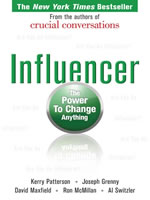 At the core of all great marketing strategies is to clearly identify who your target market is and what their problem is. This book is about the strategies for solving problems.
At the core of all great marketing strategies is to clearly identify who your target market is and what their problem is. This book is about the strategies for solving problems.
The core idea is to identify vital behaviors. A vital behavior is a “high-leverage” specific action that has measurable outcome. The author’s favorite example is Dr. Mimi Silbert, the President and Founder of Delancey Street. Since its inception in 1971, her organization has transformed 14,000 hardened criminals into professionals who earn degrees. Dr. Silbert’s vital behaviors are:
- Everyone must take responsibility for someone else’s success.
- Everyone must confront everyone else about every single violation.
These behaviors took years to develop, but her results are clear: 90% success rate. Too many behaviors, and no one can remember the rules. One or two of these “tipping-point” behaviors and you get results.
The authors believe that if you want to solve any problem, find the people who are studying best practices for that field. These researchers have already identified what works (and doesn’t). If you need to uncover your own best practices, look for places where your problem should exist but doesn’t. Then, uncover the unique behavior of the group that succeeds.
For example:
Best practices for teaching:
- Reward positive (even moderately good) performance.
- Alternate between teaching and questioning/testing.
Best practices for weight loss:
- Exercise on home equipment.
- Eat breakfast.
- Weight yourself daily.
Best practices for Guinea worm disease eradication:
- Strain water before drinking into clean vessels.
- If your neighbor has been infected, tell the community.
- Keep the infected person away from contaminating the water supply.
The second part of the book focuses on the six sources of influence (think of them as behavioral cues). These influences are needed in-concert to implement the vital behaviors.
- Personal Motivation (“Make the undesirable desirable”): Why should someone care?
- Personal Ability (“Surpass your limits”): How do they know it works?
- Social Motivation (“Harness peer pressure”): Why should they trust?
- Social Ability (“Find strength in numbers”): Why should
- Structural Motivation (“Design rewards and demand accountability”)
- Structural Ability (“Change the environment”)
I wished the authors had more lists of specific vital behaviors listed. Their website (www.VitalSmarts.com) has some additional surveys that they conducted. But I’d love to see a wiki of vital behaviors.